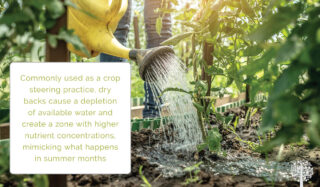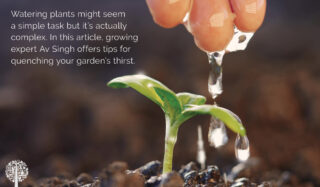
Tips and Tricks to Watering the Garden Like a Pro
The Ground Rules Of Watering The Garden
Farmers and gardeners are notorious for not recognizing their wisdom and intuition. All too often, they delegate “simple” tasks to less seasoned employees who unknowingly perform their responsibilities without the care and attention required. In farming and gardening, no task is more complex than watering, and unequivocally, it is the task that is done most poorly and leads to subsequent plant health issues. In controlled environment agriculture (CEA), the most common questions asked are, “How much water do I give and how frequently should I water?” and as any good consultant would respond, my answer is, “Well, it depends,” reminding them that watering is not for dummies!
Water, Water, Everywhere
Water is the universal solvent; we are about 60% water; plants are about 80% water; water is life, and the fun facts are endless, but when farmers water their crops, they should think about creating the right environment for their plant’s roots. Other than anchorage and energy storage, the primary function of roots is to facilitate water and nutrient uptake while maintaining the ability for gas exchange. In organic systems, nutrient availability is facilitated by microbes within the rhizosphere, allowing elements and molecules to enter the plant passively via osmosis in water or actively pumped across channels and membranes. The energy required to do so comes from respiration, where the plant root takes in oxygen to reduce carbohydrates like glucose (the end product of photosynthesis). Soil biology and soil chemistry take much of the glory regarding soil health. However, soil physics is mainly responsible for creating a root-friendly environment, which includes ample air pockets for gas exchange. Water with adequate dissolved oxygen (5 to 10 ppm) will help ensure the proper microbial populations and provide the necessary oxygen for respiration and nutrient uptake. Some common overwatering symptoms include leaf curl (low turgor pressure) and leaf yellowing (lack of nitrogen) triggered by anaerobic conditions hampering nutrient uptake.
Goldilocks’ Water
Often overlooked, water temperature significantly impacts plant growth and vigor. Plant roots cannot regulate their temperature, and once temperatures in the soil or media go outside the Goldilocks zone (for most plants, root zone temperature of 15°C to 24°C), plants will go dormant as a result of limited root system functionality, such as slowing down enzymatic reactions or altering microbial populations. Drastic fluctuations in root temperature can cause significant stresses in a root system, increasing the plant’s susceptibility to pests and pathogens. For most of the growing season, especially in controlled environment agriculture, water temperatures will range between 16°C and 20°C. Water temperatures exceeding this point will create a more hospitable environment for pathogens like Pythium or fusarium and, therefore, should be avoided.

Catering to your Plant’s Water Needs
The most significant influence on your watering regime will be your crop choice and the media in which you choose to grow it. Ideally, you have selected a crop suited best for your environment in terms of temperature, photoperiod, and humidity but have also considered soil type. Some plants can tolerate “wet feet,” meaning they can survive and even thrive in saturated soils or poor drainage. In contrast, most plants prefer well-drained soils, and once again, this primarily draws on soil biology and physics. Understanding your soil type and plant’s needs will help determine the amount and frequency of watering required for your crop. Most plant roots require 100% humidity at all times, or the root tips may die back. The vast majority of water and nutrients are taken up at the root tip, and if they die, a root must regenerate a new root tip before growing forward. A media designed to allow for depletion zones is always best to stimulate advanced root growth. Once a root has absorbed all the water and minerals in a particular zone, it will extend itself in search of more, thus creating a more robust root system with increased surface area.
Routine versus Recipe
A technique employed by many growers is called dry back. Commonly used as a crop steering practice, dry backs cause a depletion of available water and create a zone with higher nutrient concentrations, mimicking what happens in summer months. More commonly used by growers using stone wool or coco, carefully managed living soil systems can benefit from dry backs if the soil has ample wetting agent to allow the media to re-saturate. Whether watering by hand or using automated watering via emitters, many gardeners follow two fundamental rules:
- Transpiration before irrigation – meaning they will get into a routine of having the first watering event at least an hour after sunrise (or lights on).
- The last irrigation event will be at least a couple of hours before sundown (lights off).
These two principles help ensure a dry back, allowing air pockets to recharge. It is important to note that the language used is “routine” and not “recipe.” Watering should be done around the same time every day as a routine, but the grower ultimately has to decide whether the plant needs watering.
Although not ideal for efficiency, hand-watering with the proper nozzle can be the best irrigation method. The best hand waterers are patient because watering should mimic gentle rain, not tidal waves.
The next most important influence on your watering routine is the environment. Farm laborers are often blamed for overwatering or underwatering a crop when the real culprit is an unstable environment. Fluctuations in temperature or humidity will have concomitant effects on water uptake (and, by association, nutrient uptake). High temperatures coupled with lower humidity will cause excessive water loss, and plants may wilt from drought, while the opposite is true for low temperatures and high humidity.
In this situation, transpiration is reduced, and water is not being taken up as readily. If your watering routine is not modified, you will create a saturated soil with plants exhibiting symptoms of stress. In CEA, the perfect storm for molds and mildews arises from an environment inhibiting water uptake, which would limit calcium uptake, resulting in weaker cell walls, and presto, a fungal germination tube, can more readily penetrate the leaf surface and infect the plant. Once again, Nature can be a great reminder of the difference between routine and recipe. Cloudy days and days with high humidity must be met with changes in irrigation amounts and frequency to prevent overwatering.
For too long, watering has been viewed as an afterthought, a less important variable than lighting or nutrients (and this article does not even address the importance of water quality). More recently, there has been an increased emphasis on root zone manipulation, and companies are creating sensors that measure soil moisture and dissolved oxygen in soil water, etc. These tools will undoubtedly help in the future, but farmers must continue to hone their intuition on what a healthy plant looks like and place greater value on the role of watering.
Trending Articles Today
Similar Articles
Garden Ollas: An Ancient Watering Method For The Modern Gardener
They’re pretty, practical, and an ancient technique for watering plants. Ollas are an excellent eco-friendly addition to the garden; here’s how to make one.

Conserve Water In The Garden With Xeriscaping
Xeriscaping is typically practiced in dry climates, but we should all be conserving water in the garden, no matter where we live. Follow these tips and tricks.

Saving Your Harvest For Later: Water Activity And Food Preservation
It’s peak harvest season; time to talk food preservation! Dr. Callie Seaman discusses a technique that has revolutionized food safety.


